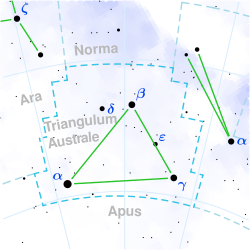Delta Trianguli Australis
Luminous G-type star; Triangulum Australe From Wikipedia, the free encyclopedia
Delta Trianguli Australis (Delta TrA), Latinized from δ Trianguli Australis, is a solitary,[14] yellow-hued star in the constellation Triangulum Australe. It has an apparent magnitude of 3.84,[2] making it readily visible to the naked eye under ideal conditions, Parallax measurements place the object at a distance of 606 light years (182 parsecs).[1] It has a heliocentric radial velocity of −4.9 km/s,[5] indicating that it is drifting towards the Solar System.
| Observation data Epoch J2000.0 Equinox J2000.0 | |
|---|---|
| Constellation | Triangulum Australe |
| Right ascension | 16h 15m 26.26978s[1] |
| Declination | −63° 41′ 08.4492″[1] |
| Apparent magnitude (V) | 3.84±0.01[2] |
| Characteristics | |
| Spectral type | G2 Ib-IIa[3] |
| U−B color index | +0.87[4] |
| B−V color index | +1.10[4] |
| Astrometry | |
| Radial velocity (Rv) | −4.9±0.7[5] km/s |
| Proper motion (μ) | RA: +2.73 mas/yr[1] Dec.: −12.92 mas/yr[1] |
| Parallax (π) | 5.37±0.17 mas[1] |
| Distance | 610 ± 20 ly (186 ± 6 pc) |
| Absolute magnitude (MV) | −2.49[6] |
| Details | |
| Mass | 6.51[7] M☉ |
| Radius | 53.6[8] R☉ |
| Luminosity | 1,210[9] L☉ |
| Surface gravity (log g) | 1.54[10] cgs |
| Temperature | 4,705±122[8] K |
| Metallicity [Fe/H] | −0.05[10] dex |
| Rotational velocity (v sin i) | 8.2±2[11] km/s |
| Other designations | |
| δ TrA, 25 G. Trianguli Australis[12], CPD−63°3854, FK5 602, GC 21819, HD 145544, HIP 79664, HR 6030, SAO 253474, WDS J16154-6341A[13] | |
| Database references | |
| SIMBAD | data |
Delta TrA has a stellar classification of G2 Ib-IIa[3] — an evolved G-type star with a luminosity class intermediate between a low luminosity supergiant and a bright giant. At present it has 6.5 times the mass of the Sun[7] and has an enlarged radius of 53.6 R☉.[8] It radiates at 1,210 times the luminosity of the Sun[9] from its photosphere at an effective temperature of 4,705 K.[8] Delta TrA has an iron abundance 89% that of the Sun,[10] placing it around solar metallicity. It spins modestly with a projected rotational velocity of 8.2 km/s, which is high for stars of this type.[11]
References
Wikiwand - on
Seamless Wikipedia browsing. On steroids.

